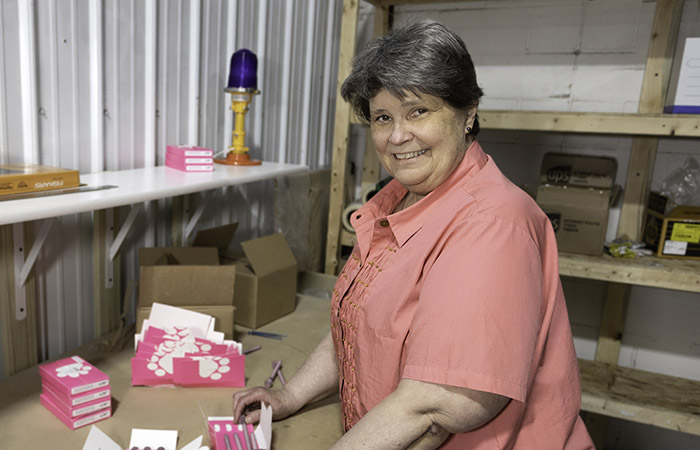Mary's Story
For Mary, a local De Pere business owner, it was a normal Wednesday. She was at work, putting nuts, bolts and screws into a box prepping for a large shipment. When her brother stopped by, he said she wasn’t making any sense.
Mary was in the emergency department for several hours, initially being treated for atrial fibrillation (AF), a type of arrhythmia or abnormal heartbeat. But, after the medication wore off, Mary started to feel worse again.
“I understood everything people were saying, but I couldn’t carry on a conversation. I couldn’t get the words to come out of my mouth,” recalled Mary.
A CT angiogram of the head was performed, and a blood clot was discovered in Mary’s brain. She was having a thrombotic stroke, which was blocking blood flow to her brain. Mary was given a choice: She could transfer to another hospital for observation, or to HSHS St. Vincent Hospital – a certified, Comprehensive Stroke Center in Green Bay – for a thrombectomy to have the blood clot removed.
“Dr. Meyer told me she was going to do surgery and that it wasn’t going to take long,” said Mary. “Once she came on the scene, I had no fear at all. This was my best shot.”
Dr. Meyer removed the blood clot through a minimally invasive thrombectomy by guiding a catheter through Mary’s groin to the blockage in her brain. In addition to removing the blockage, medication is dispersed to dissolve any small pieces of the clot that could remain and cause a future stroke.
“Everything went so well. I didn’t experience any bleeding and remember being able to speak again,” said Mary.
“Come Monday morning I felt good and walked to work,” said Mary.
For Mary, not being able to drive for 90 days after her stroke was the most challenging, but everything else felt great.
“What I learned, is if you’re having a stroke, go to St. Vincent.”
“I couldn’t get the words to come out of my mouth.”
Mary understood everything her brother said, but when she tried to answer it was difficult to find the right words. Mary’s brother knew something was wrong and took her to the emergency department at a local hospital in Green Bay.Mary was in the emergency department for several hours, initially being treated for atrial fibrillation (AF), a type of arrhythmia or abnormal heartbeat. But, after the medication wore off, Mary started to feel worse again.
“I understood everything people were saying, but I couldn’t carry on a conversation. I couldn’t get the words to come out of my mouth,” recalled Mary.
A CT angiogram of the head was performed, and a blood clot was discovered in Mary’s brain. She was having a thrombotic stroke, which was blocking blood flow to her brain. Mary was given a choice: She could transfer to another hospital for observation, or to HSHS St. Vincent Hospital – a certified, Comprehensive Stroke Center in Green Bay – for a thrombectomy to have the blood clot removed.
No fear
When Mary arrived at HSHS St. Vincent Hospital, nurses were waiting and Dr. Alison Meyer, Prevea Neurointerventional Radiologist, had already reviewed her CT scan and had a plan in place. She would do surgery that evening.“Dr. Meyer told me she was going to do surgery and that it wasn’t going to take long,” said Mary. “Once she came on the scene, I had no fear at all. This was my best shot.”
Dr. Meyer removed the blood clot through a minimally invasive thrombectomy by guiding a catheter through Mary’s groin to the blockage in her brain. In addition to removing the blockage, medication is dispersed to dissolve any small pieces of the clot that could remain and cause a future stroke.
“Everything went so well. I didn’t experience any bleeding and remember being able to speak again,” said Mary.
Home and back to work
By Friday morning, Mary was back home after Dr. Meyer decided there was no reason for Mary to be in the hospital. In fact, by Monday – only five days after her stroke – Mary was back to work.“Come Monday morning I felt good and walked to work,” said Mary.
For Mary, not being able to drive for 90 days after her stroke was the most challenging, but everything else felt great.
“What I learned, is if you’re having a stroke, go to St. Vincent.”
